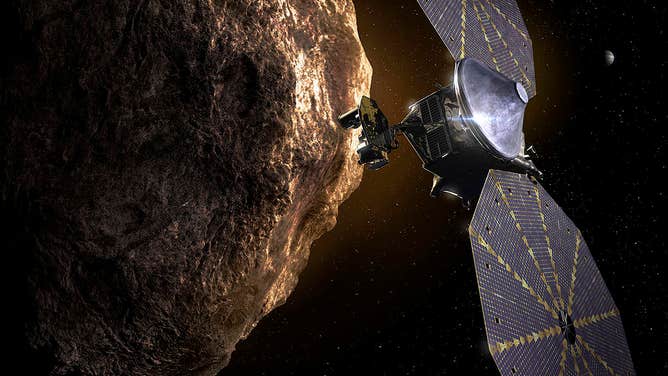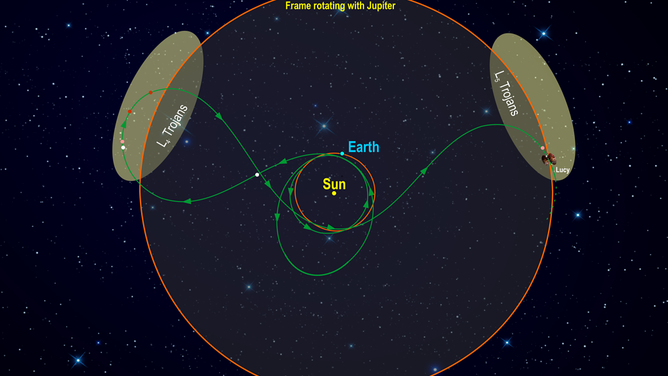NASA's Lucy spacecraft launches on quest to explore ancient asteroids
Lucy is now (really) in the sky with diamonds
Named for fossil on Earth, NASA's spacecraft Lucy began its journey to explore fossils of the solar system Saturday after launching from Florida.
United Launch Alliance successfully delivered Lucy to orbit just before sunrise, launching the Atlas V rocket from Cape Canaveral Space Force Station.
The liftoff kicks off the first robotic mission to study a group of objects known as Trojan asteroids. These asteroids are made up of the same materials as the giant planets of our solar system: Jupiter, Saturn and Uranus.
Associated with Jupiter because the asteroids are on the same orbital path, there are two groups of Trojan asteroids, one zooming ahead of Jupiter and another set trailing behind the gas giant.
Lucy was named after the fossils found in Ethiopia in 1974. The skeleton, one of human's oldest known ancestors, was named after The Beatles song "Lucy In The Sky With Diamonds" after a night of celebrating the discovery while listening to the band's songs.
Now, Lucy, the spacecraft is among the stars.
What can be learned from Trojan asteroids?

This illustration shows the Lucy spacecraft passing one of the Trojan Asteroids near Jupiter.
(Southwest Research Institute)
NASA and its research partners have focused on these asteroids because they are billions of years old and have been stuck in the same orbit, likely since creation. Researchers believe these space rocks hold clues about planet formation and possibly how life came to be on Earth.
"Trojan asteroids have witnessed first-hand the history of the outer solar system," NASA Lucy Mission Manager Sherry Jenning said in a NASA interview. "Thus, they present us with a unique opportunity to better understand planet formation and solar system evolution. These primitive bodies hold vital clues to deciphering the history of the solar system.
The spacecraft body is about the size of a large deep freezer, but it has two huge solar wings that spread out 24-feet each to power the mission.
Lucy has three science instruments that were designed with different objectives.
During each asteroid flyby, Lucy will look at surface geology, color and composition and look for any rings or satellites on Trojan asteroids.
Lucy has an instrument that previously flew on NASA's robotic flyby of Pluto, offering some of the most detailed images yet. The L'LORRI, or Long Range Reconnaissance Imager, will capture a detailed look at asteroid surfaces.
No one knows what the asteroids will look like until Lucy's images come back.
According to NASA, with eight object flybys planned for Lucy, no other mission has visited as many destinations before.
It's also unclear just how many Trojan asteroids are out there between the two swarms leading and following Jupiter, according to Lucy Principal investigator Hal Levison of the Southwest Research Institute’s branch in Boulder, Colorado.
Each asteroid is unique and offers another piece of the puzzle to how the planets formed.
"To understand what they're telling us about the history of the solar system, we have to understand that diversity," Levison said. "So Lucy itself was designed to visit as many of these things as we could. The planets literally are aligning to allow us to do this mission."
8 asteroids, 12 years, 1 spacecraft

Lucy's journey to the Trojan asteroids.
(Southwest Research Institute/NASA)
After launch, Lucy has a multi-year journey to catch up to the Trojans. The space probe will use Earth's gravity twice to sling-shot out into deep space and catch up with the asteroids. The first Earth-gravity assist will happen about one year from launch in October 2022.
Lucy will travel 4 billion miles over 12 years to complete its mission. Using a suite of science instruments on board, the spacecraft will fly by eight asteroids: one from the main asteroid belt and seven of the Trojans.
In 2025, Lucy will encounter the main-belt asteroid, Donaldjohansen, named after one of the co-discoverers of Lucy's fossils. This asteroid is Lucy's smallest target at 2-3 miles and will be used to test the spacecraft's instruments before heading to the mission target.
Two years later, Lucy will catch up to the Trojan asteroid Eurybates. This Trojan has a smaller asteroid orbiting it called Queta, allowing Lucy's instruments to study two objects with this encounter.
The final asteroid encounter will happen in 2033, concluding Lucy's work.
Lucy will remain in the stars orbiting the sun with the Trojan asteroids at the end of its mission.